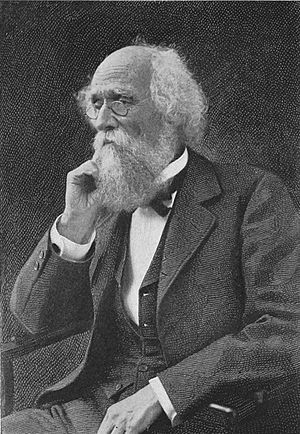Joseph LeConte facts for kids
Joseph Le Conte (born February 26, 1823 – died July 6, 1901) was an important American scientist. He was a doctor, a geologist, and a professor at the University of California, Berkeley. He also helped protect nature in California.
Early Life and Education
Joseph Le Conte was born in Liberty County, Georgia. His family, the Le Contes, were well-known. He went to Franklin College (now part of the University of Georgia) and graduated in 1841.
After college, he studied medicine and became a doctor in 1845. He practiced medicine for a few years. Later, he went to Harvard University to study natural history. He learned from a famous scientist named Louis Agassiz. A trip with his professors to the Helderberg mountains in New York sparked his strong interest in geology.
Career as a Professor
In 1851, Joseph Le Conte joined Professor Agassiz on a trip to study the Florida Reef. When he returned, he became a professor at Oglethorpe University. From 1852 to 1856, he taught natural history and geology at Franklin College.
He then taught chemistry and geology at South Carolina College (now the University of South Carolina) until 1869.
In 1846, Joseph Le Conte married Caroline Nisbet. They had four children who grew up: Emma Florence, Sarah Elizabeth, Caroline Eaton, and Joseph Nisbet Le Conte.
During the Civil War, Le Conte continued teaching in South Carolina. He also helped produce medicine for the Confederate army. After the war, conditions were difficult at the University of South Carolina. Because of this, he decided to move.
In 1868, he accepted a job offer from the new University of California. He moved to Berkeley, California, in September 1869. His older brother, John, also became a professor there. Joseph Le Conte was the first professor of geology, natural history, and botany at the University of California. He held this job until he passed away.
He became a member of the American Philosophical Society in 1873. He also wrote about how we see things with one eye (monocular vision) and two eyes (binocular vision). His main work was in geology. He wrote about how the Earth's crust moves and the big features of the Earth's surface. He published books like Elements of Geology and Evolution and its Relation to Religious Thought.
Protecting Nature and His Legacy
Joseph Le Conte was chosen for the National Academy of Sciences in 1874. He was also the president of the American Association for the Advancement of Science in 1892. In 1896, he led the Geological Society of America.
Le Conte is well-known for exploring and helping to protect the Sierra Nevada mountains in California. He first visited Yosemite Valley in 1870. There, he became friends with John Muir, another famous conservationist. They explored the Sierra Nevada together. Le Conte worried that activities like sheepherding would harm the mountains.
So, in 1892, he helped start the Sierra Club with John Muir and others. The Sierra Club works to protect natural places. He was a director of the Sierra Club for several years. His son, Joseph Nisbet LeConte, also became a professor and a member of the Sierra Club.
Joseph Le Conte died in Yosemite Valley, California, on July 6, 1901. He passed away from a heart attack.
Many places were named after him to honor his work:
- The LeConte Memorial Lodge was built by the Sierra Club in 1904.
- The Le Conte Glacier, Le Conte Canyon, Le Conte Divide, Le Conte Falls, and Mount Le Conte were named after him.
- LeConte Hall at the University of Georgia and LeConte College at the University of South Carolina are named for him and his brother.
- Le Conte Middle School in Hollywood and Le Conte Avenue in Berkeley also honor the brothers.
Both Joseph and his brother John are buried in Mountain View Cemetery in Oakland, California. Some places previously named after Joseph Le Conte were later renamed.


